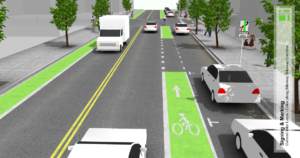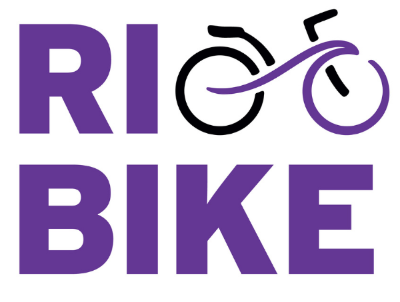
We were thrilled to participate today in a workshop on bike infrastructure design standards. The workshop was organized by Providence DPW’s Craig Hochman for City staff involved in such things, and presented by national expert Bill DeSantis of consulting firm VHB. We learned some interesting things that we thought you might be interested in.
There are three “standards” that traffic engineers use when designing bike/ped infrastructure.
- The American Association of State Highway Transportation Officials (AASHTO)’s bike guide was last updated in 2012. It’s currently in the process of being updated, but the new version probably won’t be released until 2018/19.
- AASHTO’s pedestrian guide was last updated in 2006, and is also being updated, with a less clear completion date.
- The Manual of Uniform Traffic Control Devices (MUTCD) is on its 3rd Edition, published in 2009, and a new edition isn’t expected until 2020. That’s a pretty ridiculous delay, and it’s a combination between a heavy dose of bureaucracy in the approval process and the turbulence of a new presidential administration.
These three publications hold the most legal weight, and are the bedrock of what all traffic engineers nationwide use. There are other guides too, including “references” such as
- The National Association of City Transportation Officials (NACTO)’s bike guide
- The Institute for Transportation Engineers (ITE) Traffic Control Device Handbook
- The Federal Highway Administration (FHWA) released a separated bike lane guide in 2015
- Massachusetts DOT also released a separated bike lane guide in 2015 (you may remember the BikeTalk we held about that one last winter)
These guides are all useful for providing ideas, but what engineers mostly care about is the “standards”, because the more unusual a street design, the more they worry about opening the city up to getting sued if someone gets hurt. The conflict arises because the “references” often include more progressive bike-friendly designs than the slow-to-update “standards”. There is some flexibility, though, that allows engineers to design better streets. This workshop was a step toward empowering some traffic engineers with the knowledge they need to do so.
Some street design treatments are misunderstood to be not allowed under the standards, when really they are:
 Green bike lanes have “interim approval” by FHWA, which means if a state or city asks to use it, FHWA will usually say yes in a few days, and then it’s okay. Rhode Island got that approval for green bike lanes statewide, and municipalities are thus allowed to use them. It’s just requested that you let RIDOT know first. They are approved for bike lanes and bike lane extensions, but further approval would be needed for additional uses (though what those would be, we don’t know). One point Bill always brings up is that the beloved-by-advocates NACTO guide is incorrect when it says green paint means cars have to yield to bikes. Bike lanes themselves mean that cars have to yield to bikes, and dashed bike lane extensions do not. Green paint is allowable in either case, and does not change the right-of-way/yielding implications of either.
Green bike lanes have “interim approval” by FHWA, which means if a state or city asks to use it, FHWA will usually say yes in a few days, and then it’s okay. Rhode Island got that approval for green bike lanes statewide, and municipalities are thus allowed to use them. It’s just requested that you let RIDOT know first. They are approved for bike lanes and bike lane extensions, but further approval would be needed for additional uses (though what those would be, we don’t know). One point Bill always brings up is that the beloved-by-advocates NACTO guide is incorrect when it says green paint means cars have to yield to bikes. Bike lanes themselves mean that cars have to yield to bikes, and dashed bike lane extensions do not. Green paint is allowable in either case, and does not change the right-of-way/yielding implications of either. Art or other colored paint in crosswalks was ruled by FHWA to not really help prevent collisions much, but is okay as long as the non-white paint is not reflective. A good compromise might be to incorporate the standard white reflective crosswalk and colored artistic paint into the same design.
Art or other colored paint in crosswalks was ruled by FHWA to not really help prevent collisions much, but is okay as long as the non-white paint is not reflective. A good compromise might be to incorporate the standard white reflective crosswalk and colored artistic paint into the same design. Bike boxes: The City of Providence recently got FHWA approval to put in bike boxes where appropriate citywide. This is great news, but there are a lot of caveats about bike boxes. The one that was briefly part of the Fountain Street Protected Bike Lane at Dorrance Street was taken out because you’re not allowed to have a bike lane to the right of a right-turn-only lane unless you also have a bikes-only phase of the traffic light, and without the lane, there was not a bike lane reaching the bike box. It’s theoretically feasible that there could eventually be a bike light at that intersection, but it would require A) funds to get it, and B) RIDOT approval (they own that traffic light, not the City). Additionally, bike boxes don’t help at all if the bike arrives at the intersection when the light is green. Fountain Street at Dorrance Street is an extremely tricky intersection, but since the approval is now citywide, it’s possible we could see bike boxes in simpler intersections elsewhere.
Bike boxes: The City of Providence recently got FHWA approval to put in bike boxes where appropriate citywide. This is great news, but there are a lot of caveats about bike boxes. The one that was briefly part of the Fountain Street Protected Bike Lane at Dorrance Street was taken out because you’re not allowed to have a bike lane to the right of a right-turn-only lane unless you also have a bikes-only phase of the traffic light, and without the lane, there was not a bike lane reaching the bike box. It’s theoretically feasible that there could eventually be a bike light at that intersection, but it would require A) funds to get it, and B) RIDOT approval (they own that traffic light, not the City). Additionally, bike boxes don’t help at all if the bike arrives at the intersection when the light is green. Fountain Street at Dorrance Street is an extremely tricky intersection, but since the approval is now citywide, it’s possible we could see bike boxes in simpler intersections elsewhere. Contraflow bike lanes: these were recommended in 2014 for inclusion in the MUTCD by the official committee that makes such recommendations. That means they’re not officially standards yet, but they very likely will be when the next edition is published, so they’re pretty safe for engineers to use. They just need to have a double yellow line separating them from the oncoming car traffic. That double yellow line can have a buffer as part of it.
Contraflow bike lanes: these were recommended in 2014 for inclusion in the MUTCD by the official committee that makes such recommendations. That means they’re not officially standards yet, but they very likely will be when the next edition is published, so they’re pretty safe for engineers to use. They just need to have a double yellow line separating them from the oncoming car traffic. That double yellow line can have a buffer as part of it. Buffered bike lanes: This is one step less protected than a parking-protected bike lane; it just has paint on the road separating the bike lane from the travel lane. It was also recommended for MUTCD inclusion in 2014.
Buffered bike lanes: This is one step less protected than a parking-protected bike lane; it just has paint on the road separating the bike lane from the travel lane. It was also recommended for MUTCD inclusion in 2014.- Bike lane extensions through intersections and Two Stage Turn Boxes were also recommended in 2014.
Other things we learned at the meeting:
- The AASHTO standard for bike lane width is minimum 5 feet, except when there’s no parking and all travel lanes are at their minimum width, then a bike lane can be a minimum of 4 feet wide.
- The official signs for the Fountain Street Bike Lane have been installed.
- There’s a movement to get a general policy in Providence about when to install bike lanes, so DPW doesn’t feel like we need to hold a public meeting (which is a delay and a risk of negative input) every time one is proposed.
 One of the proposals for improving the eastbound approach to the Fountain Street Bike Lane (from Broadway) is to divert bicyclists onto a contraflow bike lane on Greene Street (between the back of Regency Plaza Apartments and the back of Providence Public Library). That would allow bicyclists to go straight through the traffic light at Fountain & Empire (by Trinity Brewhouse), rather than making a scary left turn on to the new bike lane. Apparently there are some actual challenges fitting a contraflow bike lane there due to parking demand and delivery usage, but it’s still something we would love the City to give serious consideration. Another alternative that someone brought up was to have bike traffic cross 95 on Washington Street instead of Broadway (like Ella Boyan suggested over the summer) and then send bikes on Greene Street to Fountain in the same direction as traffic. That’s also an intriguing suggestion, which we’d like to hear more about.
One of the proposals for improving the eastbound approach to the Fountain Street Bike Lane (from Broadway) is to divert bicyclists onto a contraflow bike lane on Greene Street (between the back of Regency Plaza Apartments and the back of Providence Public Library). That would allow bicyclists to go straight through the traffic light at Fountain & Empire (by Trinity Brewhouse), rather than making a scary left turn on to the new bike lane. Apparently there are some actual challenges fitting a contraflow bike lane there due to parking demand and delivery usage, but it’s still something we would love the City to give serious consideration. Another alternative that someone brought up was to have bike traffic cross 95 on Washington Street instead of Broadway (like Ella Boyan suggested over the summer) and then send bikes on Greene Street to Fountain in the same direction as traffic. That’s also an intriguing suggestion, which we’d like to hear more about.
Thanks for indulging our extremely geeky post, and if you made it here to the bottom, congratulations! You’re a diligent reader. Let us know if you have any thoughts on all this.
